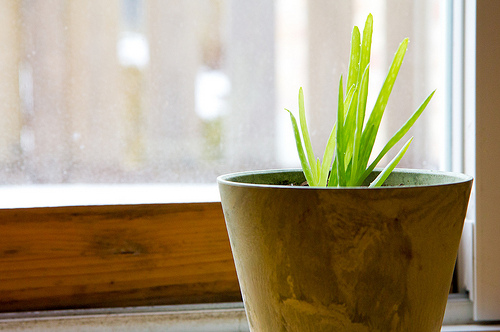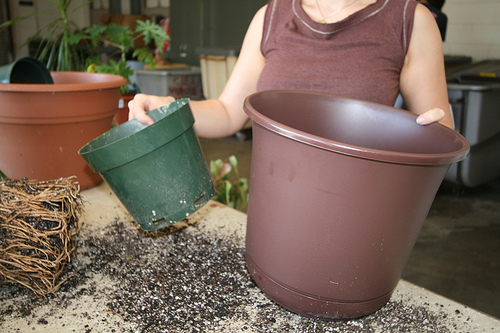When fall’s chilly temperatures arrive, it’s the end of summer vacation for houseplants that may have spent the warm season outdoors. Ensure they’ll survive and flourish in the winter with these tips for bringing outdoor plants inside.
 Aloe photo via Melz/Flickr Creative Commons
Aloe photo via Melz/Flickr Creative Commons
Timing and prepping
Many tropical houseplants can’t tolerate nighttime temperatures below 50 degrees F. So, you’ll want to bring your houseplants back indoors when temperatures regularly dip below 60 degrees F. It’s best to readjust your plants back into your home before you begin using the heat again.
Keep in mind that moving plants back inside your home will be a bit of a shock for your houseplants, as the growing conditions are quite different from their outdoor summer homes. That means you’ll need to plan ahead for the big move.
First, examine the houseplant carefully for snails, earthworms and other insects. Wash leaves and stems completely. Not sure if there are bugs? Try soaking the garden pot in a tub of lukewarm water for 15 minutes, and this will force out hidden pests.
Apply insecticidal soap on the entire plant and leave outside for a couple days, before bringing outdoor plants inside. This product is safe for pets and people, but always check the label to see if your plant is listed before using. If not, apply insecticidal soap first to a small area of the plant to test for sensitivity.
 Transplanting photo via GardeningInAMinute/Flickr Creative Commons
Transplanting photo via GardeningInAMinute/Flickr Creative Commons
Now is also an excellent time to repot houseplants into bigger containers. First scrub the pot, and use potting soil (not ordinary garden soil) to replant.
Transitioning
Don’t end your houseplants’ summer vacation too suddenly, or the shock could lead your plants to wilt, get yellowing leaves or even die.
Instead, transition your houseplants slowly to their new homes. Over a week to 10 days, reduce the plants’ light exposures so they can adjust to their new growing conditions without complaint. Move them gradually from sun to slight shade to heavier shade and then indoors. The inside of your house is usually darker than your garden outside.
Finding the right spot
Now that your houseplants are back inside, give them a good home. Try to replicate the light conditions the plants have received outdoors. For brightest conditions, place plants near a south or west-facing window. Keep plants away from cold window drafts or heater vents.
Houseplants won’t need as much water indoors. That’s especially true on grey, stormy days. Avoid overwatering your plants. Wait until the soil surface is dry before watering again
 Rex begonia photo via Gailf548/Flickr Creative Commons
Rex begonia photo via Gailf548/Flickr Creative Commons
Bringing outdoor plants inside is easier when you follow these steps, and the effort is definitely worth it.
This winter, your houseplants will add color, charm and life to your home when everything else looks dormant or dead outdoors. What could be better?

Share tips, start a discussion or ask one of our experts or other students a question.
No Responses to “What You Need to Know When Bringing Outdoor Plants Inside”